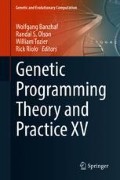Abstract
We use Genetic Programming in a machine learning approach to learn a detector of DoS-related network intrusion events. We present a one class classifier technique that trains a model from one class of data—normal, i.e., non-intrusion events. Our technique, after ensemble fusion, is competitive with one-class modeling with Support Vector Machines. We compare with three datasets and our best GP-based classifiers are able to outperform one-class SVM. For two out of four test cases, the advantage of GP classifiers when compared with one-class SVM is less than 1% which does not represent a significant improvement. On the last two cases, GP achieves significantly better results and making it a viable choice for anomaly detection task.
Access this chapter
Tax calculation will be finalised at checkout
Purchases are for personal use only
References
IEEE Standard for Floating-Point Arithmetic. IEEE Std 754-2008 pp. 1–70 (2008)
Aggarwal, C.C.: Outlier Analysis. Springer Publishing Company, Incorporated (2013)
Cao, V.L., Nicolau, M., McDermott, J.: One-Class Classification for Anomaly Detection with Kernel Density Estimation and Genetic Programming. In: Genetic Programming - 19th European Conference, EuroGP 2016, Porto, Portugal, March 30 - April 1, 2016, Proceedings, pp. 3–18 (2016)
Chang, C.C., Lin, C.J.: LIBSVM: A library for support vector machines. ACM Transactions on Intelligent Systems and Technology 2, 27:1–27:27 (2011). Software available at http://www.csie.ntu.edu.tw/~cjlin/libsvm
Curry, R., Heywood, M.I.: One-Class Genetic Programming. In: Genetic Programming, 12th European Conference, EuroGP 2009, Tübingen, Germany, April 15–17, 2009, Proceedings, pp. 1–12 (2009)
Eddy, W.M.: Defenses Against TCP SYN Flooding Attacks - The Internet Protocol Journal - Volume 9, Number 4 (2017). URL http://www.cisco.com/c/en/us/about/press/internet-protocol-journal/back-issues/table-contents-34/syn-flooding-attacks.html
Elsayed, S., Sarker, R., Slay, J.: Evaluating the performance of a differential evolution algorithm in anomaly detection. In: 2015 IEEE Congress on Evolutionary Computation (CEC), pp. 2490–2497 (2015)
Folino, G., Pizzuti, C., Spezzano, G.: GP Ensemble for Distributed Intrusion Detection Systems. In: S. Singh, M. Singh, C. Apte, P. Perner (eds.) Pattern Recognition and Data Mining: Third International Conference on Advances in Pattern Recognition, ICAPR 2005, Bath, UK, August 22–25, 2005, Proceedings, Part I, pp. 54–62. Springer Berlin Heidelberg, Berlin, Heidelberg (2005)
Habibi, A., et al.: UNB ISCX NSL-KDD DataSet (2017). URL http://nsl.cs.unb.ca/NSL-KDD/
Jakobovic, D., et al.: Evolutionary Computation Framework (2016). URL http://ecf.zemris.fer.hr/
Khan, S.S., Madden, M.G.: One-Class Classification: Taxonomy of Study and Review of Techniques. CoRR abs/1312.0049 (2013). URL http://arxiv.org/abs/1312.0049
Kuzmanovic, A., Knightly, E.W.: Low-rate tcp-targeted denial of service attacks: the shrew vs. the mice and elephants. In: Proceedings of the 2003 conference on Applications, technologies, architectures, and protocols for computer communications, pp. 75–86. ACM (2003)
Ni, X., He, D., Chan, S., Ahmad, F.: Network Anomaly Detection Using Unsupervised Feature Selection and Density Peak Clustering. In: M. Manulis, A.R. Sadeghi, S. Schneider (eds.) Applied Cryptography and Network Security: 14th International Conference, ACNS 2016, Guildford, UK, June 19–22, 2016. Proceedings, pp. 212–227. Springer International Publishing, Cham (2016)
Orfila, A., Estevez-Tapiador, J.M., Ribagorda, A.: Evolving High-Speed, Easy-to-Understand Network Intrusion Detection Rules with Genetic Programming. In: M. Giacobini, A. Brabazon, S. Cagnoni, G.A. Di Caro, A. Ekárt, A.I. Esparcia-Alcázar, M. Farooq, A. Fink, P. Machado (eds.) Applications of Evolutionary Computing: EvoWorkshops 2009: EvoCOMNET, EvoENVIRONMENT, EvoFIN, EvoGAMES, EvoHOT, EvoIASP, EvoINTERACTION, EvoMUSART, EvoNUM, EvoSTOC, EvoTRANSLOG, Tübingen, Germany, April 15–17, 2009. Proceedings, pp. 93–98. Springer Berlin Heidelberg, Berlin, Heidelberg (2009)
Overton, M.L.: Numerical Computing with IEEE Floating Point Arithmetic. Society for Industrial and Applied Mathematics, Philadelphia, PA, USA (2001)
Poli, R., Langdon, W.B., McPhee, N.F.: A field guide to genetic programming. Published via http://lulu.com and freely available at http://www.gp-field-guide.org.uk (2008). (With contributions by J. R. Koza)
R Development Core Team: R: A Language and Environment for Statistical Computing. R Foundation for Statistical Computing, Vienna, Austria (2008). URL http://www.R-project.org. ISBN 3-900051-07-0
Schölkopf, B., Platt, J.C., Shawe-Taylor, J.C., Smola, A.J., Williamson, R.C.: Estimating the Support of a High-Dimensional Distribution. Neural Comput. 13(7), 1443–1471 (2001)
Shiravi, A., Shiravi, H., Tavallaee, M., Ghorbani, A.A.: Toward Developing a Systematic Approach to Generate Benchmark Datasets for Intrusion Detection. Comput. Secur. 31(3), 357–374 (2012)
Song, D., Heywood, M.I., Zincir-Heywood, A.N.: Training genetic programming on half a million patterns: an example from anomaly detection. IEEE Trans. Evolutionary Computation 9(3), 225–239 (2005)
Tavallaee, M., Bagheri, E., Lu, W., Ghorbani, A.A.: A Detailed Analysis of the KDD CUP 99 Data Set. In: Proceedings of the Second IEEE International Conference on Computational Intelligence for Security and Defense Applications, CISDA’09, pp. 53–58. IEEE Press, Piscataway, NJ, USA (2009)
To, C., Elati, M.: A Parallel Genetic Programming for Single Class Classification. In: Proceedings of the 15th Annual Conference Companion on Genetic and Evolutionary Computation, GECCO ‘13 Companion, pp. 1579–1586. ACM, New York, NY, USA (2013)
Tsai, C.F., Hsu, Y.F., Lin, C.Y., Lin, W.Y.: Intrusion detection by machine learning: A review. Expert Systems with Applications 36(10), 11,994–12,000 (2009)
Wang, W., Gombault, S., Guyet, T.: Towards Fast Detecting Intrusions: Using Key Attributes of Network Traffic. In: Proceedings of the 2008 The Third International Conference on Internet Monitoring and Protection, ICIMP ‘08, pp. 86–91. IEEE Computer Society, Washington, DC, USA (2008)
Wu, S.X., Banzhaf, W.: The Use of Computational Intelligence in Intrusion Detection Systems: A Review. Appl. Soft Comput. 10(1), 1–35 (2010)
Zargari, S., Voorhis, D.: Feature Selection in the Corrected KDD-dataset. In: 2012 Third International Conference on Emerging Intelligent Data and Web Technologies, pp. 174–180 (2012)
Acknowledgements
This work has been supported in part by Cybersecurity@CSAIL initiative. Additionally, this work has been supported in part by Croatian Science Foundation under the project IP-2014-09-4882.
Author information
Authors and Affiliations
Corresponding author
Editor information
Editors and Affiliations
Rights and permissions
Copyright information
© 2018 Springer International Publishing AG, part of Springer Nature
About this paper
Cite this paper
Picek, S., Hemberg, E., Jakobovic, D., O’Reilly, UM. (2018). One-Class Classification of Low Volume DoS Attacks with Genetic Programming. In: Banzhaf, W., Olson, R., Tozier, W., Riolo, R. (eds) Genetic Programming Theory and Practice XV. Genetic and Evolutionary Computation. Springer, Cham. https://doi.org/10.1007/978-3-319-90512-9_10
Download citation
DOI: https://doi.org/10.1007/978-3-319-90512-9_10
Published:
Publisher Name: Springer, Cham
Print ISBN: 978-3-319-90511-2
Online ISBN: 978-3-319-90512-9
eBook Packages: Computer ScienceComputer Science (R0)

